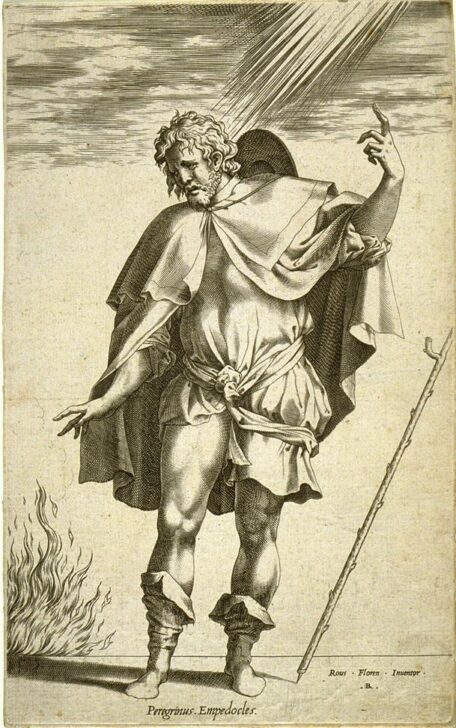Empedocles
René Boyvin

Description
Gallery Rotation Winter 2012
René Boyvin, after Rosso Fiorentino
France, active 1525–1580; Italy, 1494–1540
Empedocles
1539–40
Engraving
Museum purchase, 1990/1.189
This engraving is based on a contemporary drawing of a male figure by the Italian artist Rosso Fiorentino, who worked for the French king at the palace of Fontainbleau. It was a common practice in this period for engravers to reproduce works by other artists, making them available to a wider audience, and Boyvin was instrumental in the dissemination of Rosso’s work.
The engraving is not an exact copy of the drawing; the artist has developed the image by adding details about the subject’s identity. Beneath the figure he has inscribed Peregrinus Empedocles. The Greek philosopher Empedocles (ca. 490–430 BC) was the first ancient thinker to believe that the world was composed of four elements: fire, air, earth, and water. Empedocles also thought that terrestrial fire sought to rejoin the great fire in the sky—the sun. Thus the muscular figure that dominates the composition extends one hand towards a fire at the lower left while the other points to the sun, both details additions to the original composition. The Latin word peregrinus can mean wanderer or pilgrim and indeed Empedocles wears the hat and cloak of a Christian pilgrim, while Boyvin has added a pilgrim’s staff to the left. This attire is traditionally associated with St. Roch. Both the saint and the philosopher were great healers and their identities seem to be conflated in this work as they likely were, if less explicitly, in Rosso’s original. Another artist used the same drawing as the basis of an engraving of St. Roch, a further example of how artistic ideas were shared and developed in this era.
Subject Matter:
The first ancient thinker to believe that the world was composed of four elements: fire, air, earth, and water, Empedocles also thought that fire on the earth endeavored to rejoin the great fire in the sky—the Sun.
The figure in the engraving can be interpreted as either Empedocles or St. Roch. The inscription at the bottom, “Peregrinus Empedocles” refers to Empedocles as “foreign”, but his garb follows the traditional depictions of Saint Roch: pilgrim’s staff, hat, and cloak. Both the saint and the philosopher were great healers and the conflation of the two figures continues Rosso’s original intention of twin identities.
Physical Description:
A man wearing a tunic, cape and boots stands in a minimal landscape. His walking stick seems to be falling away from him at the right as the man points upwards toward the sun's rays, as well as extends his right hand towards fire at the lower left.
Usage Rights:
If you are interested in using an image for a publication, please visit https://umma.umich.edu/request-image/ for more information and to fill out the online Image Rights and Reproductions Request Form.